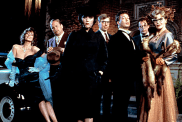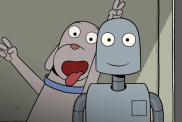Part 3 in our “Six Days of Saw” coverage!

They’re not allowed to publicly speak about what went wrong with Saw V, which was critically torn asunder, even by the most devout fans of the series, like it was a victim of Jigsaw’s many traps, but writers Marcus Dunstan and Patrick Melton will gladly talk to you about how Saw VI is an improvement.
This latest entry, directed by series editor Kevin Greutert (making his directorial debut) and coming to theaters October 23, is the third Saw film penned by the duo, also behind this summer’s The Collector and the Feast trilogy. They’ve had the unenviable task of picking up a storyline which found its principle antagonist, Jigsaw (aka John Kramer) dead. For Saw IV they deftly met that challenge head-on by telling a story than ran parallel to Saw III. In Saw V, Dunstan and Melton needed to be forward thinking and show us a world in which Jigsaw may no longer exist, but his message and pupil, carry on. Director David Hackl delivered a film that stepped up the gruesome factor (with a shocker opening and closing), yet the story stumbled about.
Nevertheless, Dunstan and Melton assure us Saw VI will put things back on the right track as they explain in our exclusive conversation below.

This is our third one out. With fourth and fifth film we were getting our footing on what the fans want. What makes a really good Saw movie, so I think with our third, we have a good grasp on that. It comes down to the “A” story. Not necessarily what John’s doing, or what Hoffman’s doing or what Amanda’s doing. It’s that “A” story that’s going to pull everyone together, the emotional hook. So there’s this new character and he’s going to bring us through to the end. With six, we put effort into it with Kevin to get a really good “A” story. It’s Peter Outerbridge, as William, and he has a connection with John and you’ll understand that early. You’ll understand the journey he has to take. When a trap starts, there’s a much more emotional connection and you’ll be rooting for this guy a bit more than you have rooted for anyone in the past.
Marcus Dustan: In terms of horror movies, Saw has been a nice introduction for four filmmakers so far. James Wan has hit it out of the park. Darren Bousman who is, right now, on Mother’s Day. Then, David Hackl is coming back and introducing a new format to these stories. Kevin Greutert, who has been a storyteller since day one, and he has crafted a tremendous visual story to go along with whatever we could have pounded out on the page. He’s a caring storyteller and he wants every audience member to feel the hit.
Melton: What he does well is, through the script process, he pays attention to the minutiae. That pays off. Especially in horror movies, there are the little things that get you. There are a bunch of little moments that set up the bigger moments.
Dunstan: It’s very emotional, too. For example the traditional Saw score didn’t quite fit this ending. It had to go in a new direction. If you were watching the endings of the previous entries, they have that Charlie Clouser score and on this, when we saw the first testing screening, Kevin was temporarily using other scores like [Requiem for a Dream]. It was building to a bigger moment emotionally. Clouser has busted his ass on this score and it’s aiming for the stands.

Well, it started with a big red wall and an apartment Patrick used to live in. We’d cover it with post-its about everything we would have loved to have seen in the first three films and everything we’d love to see in the future. Saw IV had four different representations of what it could have been based on the criteria of availability and what kind of sequel it could be. Part five was crucial because it eliminated some key characters and introduced a backbone to what was supposed to be the villain carrying the torch. Six, then, is a great proving ground for Costas Mandylor [aka “Hoffman”] to just own. And now that we see that John Kramer is the deranged version of the philosophical Punisher, and Amanda was a tweaked Punisher, Costas has proven to be the sadist. A sadist still motivated by the philosophy is tremendously creepy. This time he doesn’t have the teacher, the leash, the competition. He’ll take this town apart piece by piece until he makes it what he thinks is right. That’s exciting.
ShockTillYouDrop.com: Kevin had mentioned to me that the mafia was considered to be involved plot-wise this time aroundâ¦
Melton: The Saw process is really strange. The producers have always been involved, the studio, then there’s us and the director. We’re doing these so fast so it’s “okay, this is where the last movie is going to end” plus we don’t know what the fan reaction is going to be, so getting the story down is often tricky. Somebody brought up the mafia thing at one point and that was squashed. A lot of times it springboards into something else and it did. The idea coming out of five with Hoffman, you see he’s punishing people who get off. Vigilante justice. When the note came up, I think they were thinking, “oh since he does that, he’d be going after the mafia.” It just didn’t feel Saw enough. We’re just making The Punisher. Once seeing part six, you’ll see how Hoffman operates and you’ll see he’s pretty demented. He’s not that coherent: This person is good, this person is bad. It’s very gray for him.
Dunstan: He also has the difficult task of being two people. He’s, as the audience knows, this vicious man, but there’s also the decorated officer and that allows him to pick some good prey.

ShockTillYouDrop.com: In a Dexter sort of way.
Dunstan: Yeah, he has a rough time finding that balance because the vicious man is pretty powerful.
Melton: Costas was introduced in three in a strange moment and he stuck out like a sore thumb. We had to carry that over to four and five. But I don’t think you have a good idea of what he’s about in those two, how his mind works. Six clarifies that a little more, because now we know his secret so you’re seeing his mind operate and him playing with these two people he is. Six brings Hoffman out as a much more interesting character, someone you could get behind.
Dunstan: It almost seemed like he was being held back by the suit and the tie, there’s obviously a pro wrestler in thereâ¦
Melton: Costas is a very charismatic actor. Now, he’s able to do that more, show that side of him where you see how he plays these people to set up the big ending. That’s where the fun is with that one. And it brings a bunch of questions to the forefront. What was he like with Amanda? How did they get along? How about Hoffman and John? Because their philosophies seem to contrast quite a bit. All of that is answered in six. It doesn’t feel like we’re rehashing anything. These are all-new scenes, it’s not expository info, it’s info aiding the “A” story which lends to a cool pay-off in the end. The flashbacks are proactive this time around. They’re not there to show you a cool angle of a scene you’ve seen before.
Dunstan: And that’s thanks to Kevin. He wanted every scene to drive information on three different levels. What you need to get through the story. Make a shock or a scare. Then say something that’s not necessarily spoken. What is Kevin’s camera telling you about this scene and I like that a lot.
Melton: There is an end goal in sight, too, which helps. There’s a light at the end of the tunnel we’re leaning towards from four to five to six. When six ends, it could be the last, even though we know it isn’t now. [laughs]

ShockTillYouDrop.com: Is seven going to offer a new beginning or a new arc?
Dunstan: Seven had to answer a lot of questions even in its concept. If the film is going to be 3-D, why would you ever do a Saw movie in 3-D? Once that question was answered, we came up with a way to terrorize the viewer no other film in 3-D can do. Not even the big guns. This is something specific this series can shock someone with and reinvigorate the series. While six offers a nice bit of closure it also kicks another door open. If you can see that this happened now “x” can happen and that was great. The transition from closing out six and starting seven has been the most streamlined yet. At this point in the year, we should be probably brainstorming. No, the script is on draft three and things are being sketched out and it’s out to earn its place.
Melton: When six ends, John’s plan is clearly complete and this is how he intended it to end. But, something happens and that’s the natural springboard. You’ll understand what his final message was and where it needs to go.
Shock: How many traps can we expect from six?
Dunstan: Well, I know we’ve been comparing to the others and we’ll say they’re the most vicious of the series.
Melton: They’re definitely bigger and involve more people.
Dunstan: Once again, learning from previous entries, we’re trying to refine the traps we’ve always loved. This one got under my skin, why don’t we turn it up to 12?
Melton: We regulate the escalation, too. So the film ends on the best trap.





Source: Ryan Rotten, Managing Editor









